| Srl | Item |
| 1 |
ID:
086855
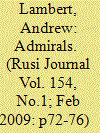

|
|
|
|
|
| Publication |
2009.
|
| Summary/Abstract |
Historically, the job of the admiral was to make high level decisions that affected the conduct of war, or the preservation of peace, far from home, and without access to the advice of kings or queens, statesmen and ministers. This article charts the necessary qualities and gifts of successful British admirals throughout the ages.
|
|
|
|
|
|
|
|
|
|
|
|
|
|
|
|
| 2 |
ID:
048740
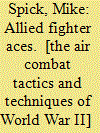

|
|
|
|
|
| Publication |
London, Greenhill Books, 1997.
|
| Description |
239p.Hbk
|
| Standard Number |
1853672823
|
|
|
|
|
|
|
|
|
|
|
|
Copies: C:1/I:0,R:0,Q:0
Circulation
| Accession# | Call# | Current Location | Status | Policy | Location |
| 039792 | 940.544/SPI 039792 | Main | On Shelf | General | |
|
|
|
|
| 3 |
ID:
070234
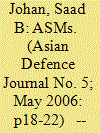

|
|
|
| 4 |
ID:
129299
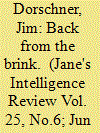

|
|
|
| 5 |
ID:
123481
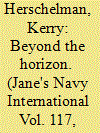

|
|
|
| 6 |
ID:
113973
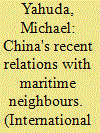

|
|
|
|
|
| Publication |
2012.
|
| Summary/Abstract |
Chinese maritime assertiveness since 2008 is a product of China's growing economic and military power combined with a centrally fostered nationalism. Although incidents with several maritime neighbours may not have all been initiated by China, the Chinese over-reacted. Matters were made worse by the opacity of Chinese decision-making processes and by problems of governance as shown by the multiplicity of Chinese authorities in charge of separate naval forces. The American 'pivot' to Asia provides neighbours with a hedge against an overbearing China, but they still need to cultivate relations with China on whom they are economically dependent.
|
|
|
|
|
|
|
|
|
|
|
|
|
|
|
|
| 7 |
ID:
072239


|
|
|
| 8 |
ID:
114042
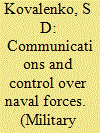

|
|
|
|
|
| Publication |
2012.
|
| Summary/Abstract |
The author discusses the specifics of communication with naval forces in various environments. He shows ways of improving naval communications facilities in view of the interservice standardization of the Russian Armed Forces' control system.
|
|
|
|
|
|
|
|
|
|
|
|
|
|
|
|
| 9 |
ID:
102864
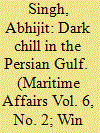

|
|
|
|
|
| Publication |
2010.
|
| Summary/Abstract |
This article reviews the sustained growth of Iran's naval forces in the past two decades. It closely examines the Islamic Republic's navy's war-waging capacity in the Persian Gulf, its new unconventional fighting philosophy, force imperatives, doctrinal underpinnings, combat objectives, and the implications that this might have on shipping and oil trade in the Persian Gulf. Experts have long speculated that Iran is developing its asymmetric capabilities aimed at paralysing the Persian Gulf and the eventual expansion of its sphere of influence. Interfering with the supply of oil would raise oil prices sharply and would certainly stall the still moderate global economic recovery, thereby plunging the world again into a global recession. Analysis shows that the modernisation of its naval forces might be the clearest indication that Iran may well be systematically developing the means to do so. This is brought home starkly by the beefing up of the Revolutionary Guards' Navy and its "swarming" capabilities. With a newfound assertiveness and aggressive tactics, the Iranian naval forces are now challenging the dominant force in the Persian Gulf - the US Navy. And even though the success of such an approach at this stage appears unlikely, they may still hold some key cards, to be able to pose a credible and effective threat.
|
|
|
|
|
|
|
|
|
|
|
|
|
|
|
|
| 10 |
ID:
126284
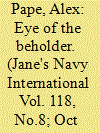

|
|
|
| 11 |
ID:
092093
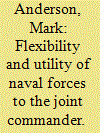

|
|
|
|
|
| Publication |
2009.
|
| Summary/Abstract |
The attacks in Mumbai last year were a wake-up call to wider world, not merely in their audacity or their target, but also in the method by which the terrorists chose to enter India.
|
|
|
|
|
|
|
|
|
|
|
|
|
|
|
|
| 12 |
ID:
122513
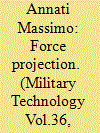

|
|
|
|
|
| Publication |
2012.
|
| Summary/Abstract |
Aircraft carriers have been considered, for long time, the long stick of major maritime powers, capable to project force ashore and themselves a proud symbol of naval power. Todaym only a few European countries operate a carrier force: France, Italy and Spain, while the UK with a shocking decision, withdrew all the embarked fixed wing aircraft and terminated a long and proud tradition.
|
|
|
|
|
|
|
|
|
|
|
|
|
|
|
|
| 13 |
ID:
133067
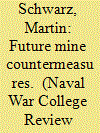

|
|
|
|
|
| Publication |
2014.
|
| Summary/Abstract |
Admiral Smith's point might be as valid today as it was sixty-four years ago. It refers to mines that he faced off the coast of Korea. Naval (or sea) mines are, by themselves or in combination with other weapons, a promising choice to parties pursuing antiaccess/area-denial objectives. The number of mines in the stocks of countries around the world and the ease of laying them mean that sea control is very likely to be lost again in future tension and conflict. This article is an attempt to describe the means, and to some extent the methods, under consideration to win it back if the need arises again. Mines pose a threat not only to military use of the sea but also to civilian shipping. The global economy depends on secure access to the global commons. With roughly 95 percent of world trade being shipped by sea, it is clear how much the economy depends on open trade routes and sea areas.1 Therefore, the capability to counter mine threats is needed to provide freedom of movement not only to one's own and friendly naval forces but to merchant shipping as well.
|
|
|
|
|
|
|
|
|
|
|
|
|
|
|
|
| 14 |
ID:
122333
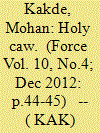

|
|
|
| 15 |
ID:
131918
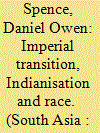

|
|
|
|
|
| Publication |
2014.
|
| Summary/Abstract |
This article examines the colonial legacies in the development of the Indian and Pakistani navies following Independence. As both navies struggled with problems of indigenising their forces, Britain endeavoured to maintain its regional hegemony by extending the professional dependency of both. The influence of imperial ideologies and racial discourses of power on these relationships and on Indian naval identity caused India's and Pakistan's navies to evolve in different directions, as did Cold War geopolitics and civil-military relations. By analysing the challenges faced by India in achieving strategic independence, this article widens existing debates surrounding the neo-colonialism of Indian governance and education during the Nehruvian period, the reinvigoration of Empire and the limits of British imperial power after World War II.
|
|
|
|
|
|
|
|
|
|
|
|
|
|
|
|
| 16 |
ID:
086789
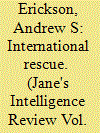

|
|
|
|
|
| Publication |
2009.
|
| Summary/Abstract |
The Chinese People's Liberation Army Navy (PLAN) dispatched three naval vessels to support international counter-piracy operations in the Gulf of Aden in December 2008. This muscular effort is the clearest sign so far that Beijing is growing in its willingness and capacity to deploy military assets overseas to protect Chinese citizens and commercial interests.
|
|
|
|
|
|
|
|
|
|
|
|
|
|
|
|
| 17 |
ID:
132166
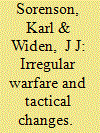

|
|
|
|
|
| Publication |
2014.
|
| Summary/Abstract |
The aim of this article is to analyze the tactical behavior of Somali pirates, international naval forces, and the shipping community operating in the Gulf of Aden and the Somali Basin. To what extent has tactical behavior changed over time and can this process be understood in more theoretical terms? Our theoretical framework centers around some concepts often used in naval doctrine, discussing tactical change in terms of command and control, force, mobility, protection, intelligence, and endurance. We also evaluate this change using two tactical concepts-tactical adaptation and tactical development. The empirical data is based on statistics from the International Criminal Court-International Maritime Bureau and the EU NAVFOR Operation Atalanta, as well as interviews. We conclude that Somali piracy has unquestionably adapted their tactics to circumstances, while naval forces have increased their capacity to capture pirates and shipping to avoid pirates.
|
|
|
|
|
|
|
|
|
|
|
|
|
|
|
|
| 18 |
ID:
128660
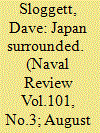

|
|
|
|
|
| Publication |
2013.
|
| Summary/Abstract |
Today Japan faces a myriad of military threats. How it is responding to those through the deployment of naval forces provides a model for other states in the region.
|
|
|
|
|
|
|
|
|
|
|
|
|
|
|
|
| 19 |
ID:
133078
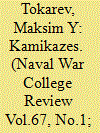

|
|
|
|
|
| Publication |
2014.
|
| Summary/Abstract |
Throughout history, despite the influence of Alfred Thayer Mahan's concepts, continental European and Asian navies have had a simple choice to make: either to create a balanced fleet to engage another balanced fleet at sea and defeat it in one or more "decisive battles" or to take an "asymmetrical approach," creating an "unbalanced" navy, able to prevent the enemy from achieving sea control and to keep one's own vital sea lines of communication (SLO Cs), if one has any, untouched by the enemy's naval forces.
|
|
|
|
|
|
|
|
|
|
|
|
|
|
|
|
| 20 |
ID:
132853
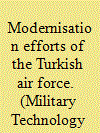

|
|
|
|
|
| Publication |
2014.
|
| Summary/Abstract |
The Turkish air force command was established with the purpose of preventing threats and dangers likely to come from the air against turkey, and facilitating success for the land and naval forces during a time of war.
|
|
|
|
|
|
|
|
|
|
|
|
|
|
|
|